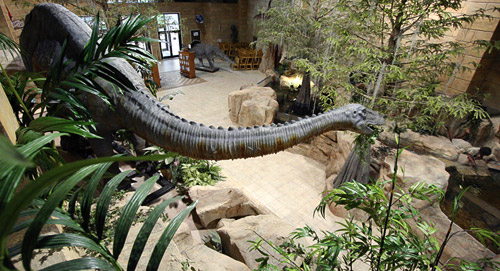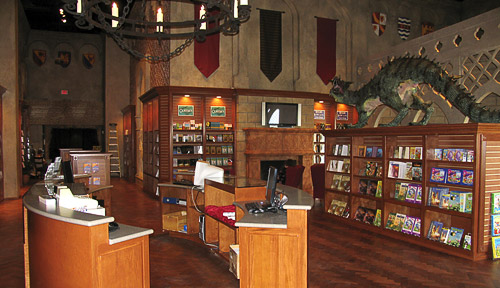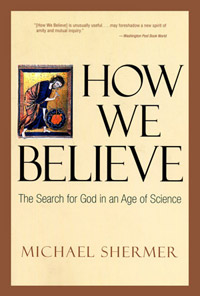New Einstein Biography
a NY Sun review by Michael Shermer
Recently, Michael Shermer reviewed the new biography by Walter Isaacson entitled Einstein: His Life and Universe (Simon & Schuster, 2007, ISBN 0743264738). The review was published by the New York Sun on May 9, 2007. Here’s a snippet:
In the final weeks of his life Albert Einstein learned of the death of his old physicist friend Michele Besso from his Zurich student days six decades before. “He has departed from this strange world a little ahead of me,” Einstein wrote to the Besso family. “That means nothing. For us believing physicists, the distinction between past, present and future is only a stubborn illusion.”
What did Einstein mean by “us believing physicists”? Did he mean belief in the models of theoretical physics that make no distinction between past, present, and future? Did he mean belief in some impersonal force that exists above such time constraints? Was he just being polite and consoling? Who knows? Such is the enigma of the most well-known scientist in history whose fame was such that nearly everything he wrote or said was scrutinized for its meaning and import; thus, it is easy to yank such quotes out of context and spin them in any direction one desires. Without a rich personal context in which to situate Einstein’s thoughts and theories it is hard to know for sure how to nuance his words. Until now…
Special on signed first edition Shermer book
on why people believe in God
A limited number of signed first edition copies of Michael Shermer’s hardcover book, How We Believe, that presents his theory on the evolutionary origins of religion and why people believe in God, is now available at the special price of $10. If you would like the book personalized please tell us to whom it should be autographed in the “Customer Comments” section during checkout. In How We Believe, Shermer shows the power of belief systems, the role of mythmaking and storytelling in human cultures, the anthropology of cargo cults, the eschatology of end times myths, the sociology of destruction-and-redemption myths, the psychology of religious belief and disbelief, and the results of a study on why people believe in God. ORDER the book >
If a picture is worth a thousand words, a 3-D museum exhibit is worth a thousand pictures. In this week’s eSkeptic we publish a review of the new young-earth creationism museum in Kentucky, visited by our colleague and correspondent Stephen Asma, a professor of philosophy at Columbia College Chicago who is well equipped to evaluate the museum on its own terms, as he has published a book on natural history museums with Oxford University Press (2001) entitled Stuffed Animals and Pickled Heads: The Culture and Evolution of Natural History Museums. Come join Stephen on a journey into the distant past (4000 years ago) when dinosaurs ruled the decks on Noah’s Ark and the universe was created around the same time that the Egyptians invented red wine.

A 40-foot-long animatronic sauropod dinosaur — one of several in the Main Hall that are engineered to move. While the fanciful scallops along the neck have long been a staple of cartoon dinosaurs, they not supported by any osteological evidence.
Solomon’s House
The Deeper Agenda of
the New Creation Museum in Kentucky
by Stephen T. Asma
“How many sheep would a dinosaur need to eat per day while living on the Ark?” This was the question I posed to Ken A. Ham, the director of the new Creation Museum in Kentucky, which I toured for Skeptic. My question harkened back to the 1660s and John Wilkins’s 1668 An Essay Towards a Real Character and a Philosophical Language, where I learned that “atheistical scoffers” had been rolling their eyes at the notion that so many animals could fit on so small a boat (300 cubits = 450 feet long, 75 feet wide, and 45 feet high, says Genesis 6:15). Bishop Wilkins, who acted as the first secretary of the Royal Society, set about demonstrating once and for all that the ark could indeed hold the menagerie. Creating elaborate charts based on scriptural descriptions of Noah’s craft and cargo, Wilkins established that the middle floor of the three-floor ark was just under 15-feet tall and held foodstuffs for all the passengers, including 1,600 sheep for carnivore consumption. So naturally when I learned that Ham’s new exhibit diorama would show visitors how the dinosaurs lived on the ark (something Wilkins couldn’t have predicted), it seemed reasonable to ask how many sheep they’d be digging into.
“Well, that’s an interesting question,” Ham replied nonplussed. “We don’t know for sure, but from a biblical perspective we know that all animals were originally herbivores.” (Carnivore activity only happens as a result of the Fall — animals did not experience death before Adam’s sin.) “So it is possible that carnivores ate plants and grains while they lived on the ark. Even today we know that grizzly bears eat grass and vegetation primarily, so it’s not true that an animal with sharp teeth and claws must eat meat or must be a carnivore. At the very least, the carnivores could survive on vegetation for a significant time span.”
I was surprised to find myself relieved that Ham was unfazed by my line of inquiry. Something slowly happens to your criteria for “reasonableness” as you become immersed in a creationist worldview. Ham and I were having a perfectly reasonable conversation — if only we had been living in the 1600s. Ham’s speculation about Ark-board vegetarians seemed, at least for a moment, ingenious because it simultaneously cut down on the physical space needed for food (grains and vegetables can be compressed to take up less space than sheep) and eliminated another 1,600 mouths to feed. Bishop Wilkins would have been proud.
The $27 million Creation Museum opened its doors to the public in May 2007. This evangelical museum is an offshoot of Answers in Genesis (AiG), which is run by Ham, who holds a B.S. in applied science from the University of Queensland, is author of titles such as The Lie: Evolution, and Walking Through Shadows: Finding Hope in a World of Pain. In addition to books, AiG produces a creationist magazine, and a variety of Christian DVDs, CDs, and so on. He and his board of directors, each of whom he describes as “a godly man who walks with the Lord in wisdom and maturity” have been “upholding the authority of the Bible” since 1994.
Ham and his organization believe that the time is ripe for a rebuttal museum. The promotional material on the AiG website states, “Almost all natural history museums proclaim an evolutionary, humanistic worldview. For example, they will typically place dinosaurs on an evolutionary timeline millions of years before man. AiG’s museum will proclaim the authority and accuracy of the Bible from Genesis to Revelation, and will show that there is a Creator, and that this Creator is Jesus Christ (Colossians 1:15–20), who is our Savior.” Located in Petersburg, Kentucky, near Cincinnati, the museum has an elaborate walk-through exhibit of Noah’s ark. As you enter the giant exhibit you encounter 12 animatronic figures building the vessel. You can then meander around two floors of animal pairs, walking both inside and outside the ark. There is also a display of the design plan of the ark to lend scale, demonstrating to visitors that this massive diorama represents only 1 percent of the total ark space. The walls are covered with mural paintings that show how Noah’s family took care of the animals, including engineering speculations about food and waste management. And crucial to the logic of the entire ark display is the exhibit showing how two of every “kind” of animal was brought on board, not two of every “species.”
If Noah had to get every species on board, then Ham and the other Creationists would be in deep trouble. The Amazon rain forest alone, according to some researchers, may contain as many as 20 million species of arthropods, which are themselves only a piece of the rain forest biosphere. The popular college textbook Biology (Campbell, Reece and Mitchell) sums up the numbers by saying that, “To date, scientists have described and formally named about 1.5 million species of organisms. We can only estimate how many more currently exist. Some biologists believe that the number is about 10 million, but others estimate it to be between 30 million and 80 million.” Even if we take the most conservative numbers of species and then add the staggering numbers of now extinct species (like the dinosaurs), we have an insane amount of animals to fit on a boat that’s less than two football fields long.
But the Creation Museum argues that Noah never had to take two of every species, but only two of every “kind,” and that cuts the numbers enough to reasonably pack the boat. What is a “kind”? Creationists are invoking the next level up on the ladder of taxonomy, the genus. To skeptics who think there were too many species of dinosaur to fit on the ark, for example, Ken Ham responds: “there were not very many different kinds of dinosaurs. There are certainly hundreds of dinosaur names, but many of these were given to just a bit of bone or skeletons of the same dinosaur found in other countries. It is also reasonable to assume that different sizes, varieties, and sexes of the same dinosaur have ended up with different names. For example, look at the many different varieties and sizes of dogs, but they are all the same kind — the dog kind! In reality, there may have been fewer than 50 kinds of dinosaurs.” In reality, scientists estimate that there were over 2,000 genera of dinosaurs.
I asked Ham if just a handful of dinosaurs wouldn’t be too big (even in smaller genera numbers) to accommodate on the ark. “We want people to understand that of all the fossil skeletons found around the earth, the average size of dinosaurs is only the size of a sheep,” he responded. “We also want to point out that dinosaurs probably don’t have a growth spurt until after five years, so they could be quite small when young. Therefore, it’s not ridiculous to think that two of every kind were on the ark.”
It’s worth noting that while Ham and others are trying to make the animal kingdom smaller so it will fit into the boat, earlier exegetes entertained the idea of making the ark much bigger in order to accomplish the same goal. Augustine, for example, argued that the biblical “cubit” was really more like 9 feet long, rather than the 1.5 feet that we usually accept. But John Wilkins put the brakes on that when he applied this new cubit to other biblical passages, pointing out that if Augustine and others were correct, it would also make Goliath’s head nine feet tall, simply too big for David to carry.
The Museum teaches that plant kinds would have survived the flood as floating mats of vegetation, and insects and invertebrates would have lived on them, instead of inside the ark. And so on. My purpose here isn’t to refute each and every claim, but to highlight that the main agenda behind it all is to make the world a much smaller place. The Creation Museum is not just trying to shrink the animal kingdom, it is also scaling back the universe.
The world is ancient and vast. The Big Bang occurred 13.7 billion years ago; the earth is approximately 4.6 billion years old; life itself (single-cell organisms) emerged a few hundred million years later; dinosaurs went extinct 65 million years ago; and modern humans developed from ancestral hominids around 100,000 years ago. But the Creation Museum is speaking to the increasing number of Americans who believe they live in a world created by God 6,000 years ago; that a great deluge covered the earth 4,400 years ago; that species have gone extinct within the last several thousand years and no new species have evolved; and the savior came 2,000 years ago and will come again soon to wrap up the whole enchilada.
In order to maintain this insular picture of nature, the Creation Museum offers an exhibit illustrating the rapid formation of the Grand Canyon, which they claim happened during the great flood, rather than over the course of millions of years as current geology contends. When I asked Ham if there was any particular museum exhibit that might prove conversionary for the skeptic, he underscored the importance of the young-earth doctrine. “I think one of the big issues in this whole topic is obviously the age of the earth — the question of millions of years versus thousands of years. That issue is even more key than the business of Darwinian evolution. And I believe that there is very compelling evidence in our displays — and in the DVDs that we produce — to show that the earth is not millions of years old.”

According to the The Answers in Genesis website, The Creation Museum’s medieval-themed Dragon Hall Bookstore offers “a wealth of Bible affirming science, worldview and family resources in a dramatic setting.”
What is really on display here is what Max Weber called the “enchanted garden” — a magical place wherein God cares about human beings and codes nature with secrets and signs of his power and purpose. The scientific world view, by contrast, presents what Stephen Jay Gould once described as “the ‘cold bath’ theory that nature was not constructed as our eventual abode, didn’t know we were coming (we are, after all, interlopers of the latest geological microsecond), and doesn’t give a damn about us (speaking metaphorically).” However, Gould concludes, “I regard such a position as liberating, not depressing.”
The Creation Museum, on the other hand, finds this “cold bath” view very depressing, and it is the reason, the organizers say, why the American family is disintegrating. Ham’s Answers in Genesis Web site laments that “the devastating effect that evolutionary humanism has had on society, and even the church, makes it clear that everyone — including Christians — needs to return to the clear teachings of Scripture and Genesis and acknowledge Christ as our Creator and Savior. In fact, Genesis has the answer to many of the problems facing the compromising church and questioning world today.”
One of the developers of an evolution exhibit at Chicago’s Field Museum, Eric D. Gyllenhaal, told me that curators will often do front-end surveys and exit surveys of visitors to see what they knew before going through the exhibit and what they knew and felt afterward. Curators do this to see if their “message” is getting through. Unprompted, patrons exiting the Field’s evolution exhibit reported a strong sense of their own “fragility” as a species, and many visitors reported feeling very “small” in comparison with the vast scales of geological time.
In that vein, I asked Mark Looy, vice president for Answers in Genesis ministry relations, what the intended “message” was for the creation museum. “The message is that the Bible is true. We’re not trying to hide that from anyone — the museum will be an evangelistic center.” Many mainstream moderate Christians read the Bible figuratively rather than literally and they see God as the maker of natural laws, from the Big Bang to natural selection. They are comfortable with modern science and for them God is not a micromanager of nature, nor an intruder on the free-will affairs of the human species. But the Creation Museum characterizes those moderates as part of the problem.
I asked Looy if moderate Christians, or any “theistic evolutionists,” would enjoy the museum. “Well, we welcome them to the museum to observe two things; one, the evidence that supports Genesis and shows them that they don’t need to compromise with the evolutionists,” he began. “And two, we’ll also challenge them with the question, Why would an all-powerful, all-knowing God use something so cruel and wasteful as Darwinian evolution?”
The museum does not shy away from the traditional “problem of evil” by saying that suffering does not exist, or by saying that it only looks like suffering to us but it’s really good from a God’s-eye perspective. Instead, it offers a disturbing progression of exhibits that move the visitor from the “Cave of Sorrows,” where Eve eats from the Tree of Knowledge, to “The First Shedding of Blood,” where images and text explain how animals began to suffer and die after God’s wrath at the fallen Adam and Eve. So, the museum accepts the reality of natural selection’s brutality (all organisms tend to make more offspring than can survive to procreative age), but it places the blame for this unpleasantness on man’s shoulders, not the Deity’s.
Scientists observe the “carnage” of natural selection and see it as the engine of adaptation and speciation. Creationists observe the same carnage and explain it as divine punishment, with no evolutionary significance. The gap reminds us that data usually underdetermine the theories that are proffered to explain them. In other words, we can usually give more than one coherent explanation for the same data. The people at the Creation Museum were eager to point that out to me, whenever they could.
“The big issue in the museum that we deal with,” Ham said, “is helping people to see the difference between using the scientific method in the present — what’s called operational science — and one’s origin beliefs.” Looy added: “An evolutionist looks at a dinosaur bone and says it must be 65 million years old. We look at the same bone and say that the creature was probably covered by a global flood about 4,400 years ago. Same evidence, same bone, just a different interpretation.”
Is there room for this quirky creature, the Creation Museum, on today’s ark of natural history museology? Natural history museums began to emerge as public and professional institutions in the 17th century. Prior to that, collecting and displaying were active private fetishes for bourgeois Europeans. These wunderkammer or kunstkammern were jumbled, unsystematic cabinets that contained natural and artistic exotica. Whenever some overarching narrative of meaning was applied to the collections, it was invariably a celebration of the Creator’s ingenuity and fecundity — as in the case of Konrad Gesner’s explanation (Historiae Animalium) of his insect collection: “These little creatures so hateful to all men, are not yet to be despised, since they are created by Almighty God for diverse and sundry uses. First of all we are forewarned of the near approaches of foul weather and storms; secondly, they yield medicines for us when we are sick, and are food for diverse other creatures, as well as birds and fishes. They show and set forth the Omnipotency of God, and execute his justice.”
In many ways, Ham’s new Creation Museum is more in keeping with this early museology. The purpose of investigating and displaying the Book of Nature is to further amplify the Holy Book. But as the budding sciences began to organize into disciplines and savant societies during the late 17th and early 18th centuries, private collections were bequeathed, purchased, and consolidated into real “Solomon’s Houses” (an influential term invented by Francis Bacon to describe fictional wisdom warehouses of specimens). The professional science institutions (e.g., London’s Royal Society, the American Philosophical Society, the Académie des Sciences, etc.) developed hand-in-hand with the growth of theoretical collecting (taxonomic, medical, and eventually evolutionary). By the time flagship American museums such as Chicago’s Field Museum, New York’s American Museum of Natural History, and the National Museum of Natural History came to life in the 19th century, the theoretical map was squarely Darwinian. And the educational or rhetorical mission of the museum was to help average citizens to appreciate the general evolutionary history of the fossils, skeletons, and taxidermy on display.
In the 1940s and 1950s museum directors like Albert Eide Parr, at the American Museum of Natural History, began to redirect their giant institutional “arks” toward the new mission of ecology education and research. In 1943, for example, Parr begged an esteemed group of curators at the Field Museum to follow his lead and focus the new message on local ecology issues rather than exotic entertainment. And besides, he argued, the old mission of educating citizens about evolution had been successfully accomplished by now. That’s right — curators in the 1950s believed that evolution theory was now firmly entrenched in the common-sense of mainstream America. The irony is delicious. Dim the lights, cue the diorama of Ham’s evangelical anti-Darwin displays, and watch the rapid spinning of Dr. Albert Parr in his grave.
But while the respectable museums have standardized and harmonized their messages to accurately portray our state of scientific knowledge, the smaller-scale museums have always continued to percolate their mess of idiosyncratic specimens and ideologies. In the 20th century, the difference between respectable and suspicious institutions is usually signaled by money. Oddball museums typically don’t have much money, so the rhetoric or persuasiveness of their message is usually tarnished by the seedy patina of low-budget constraints. But the $27-million dollar Creation Museum, which continues to pick-up steam in big-budget patronage, is poised to bring new celebrity to unorthodox curating.
Those of us who take a guilty pleasure in quackery of all kinds will be wont to keep this Creationist oddity on board the ark of museology, despite it’s illegitimacy. As long as we know what it’s about, we can enjoy its aesthetic and even its peculiar logic. Said Looy: “An independent marketing group out of Indiana says that a ‘sizable minority’ of visitors to the museum will be skeptics, atheists, and non-Christians. Our museum is going to be even more evangelical than what we intended two or three years ago.” And this rhetorical melodrama will of course make the museum visits all that much more fun for me and my twisted ilk.
When I think, however, of the young children who are unprepared to critically assess the museum, my sense of humor fades. It is one thing to offer alternative histories, but to link huge branches of science with moral corruption is not going to be good for the cultivation of open-minded, curious citizenry. The socially conservative political stance of the museum is prevalent in almost every exhibit, but the coup de grace is the “Culture in Crisis” exhibit. Here the museum gives us a “natural history” of the breakdown of the American family. Visitors are invited to look through three windows of a contemporary American home. Videos loop to show two young boys looking at porn on the computer and experimenting with drugs. Another window shows a young girl crying, surrounded by abortion pamphlets. And finally the parents are shown arguing. A recreated church facade stands at the other end of the room, but the foundation of the church has been damaged by a large wrecking-ball labeled “millions of years.” The signage explains that the cause of all this misery is our move away from Genesis and toward the scientific ideas of geology and evolution. Ideas about an old earth make people feel small and insignificant, so naturally they do drugs and have abortions.
It is sad to imagine what kind of attitude people will have toward science and the empirical study of nature when they have been raised to believe that such studies cause nihilism and immorality. I guess the dinosaurs really are on the ark with us. Let’s hope they’re vegetarian after all.













